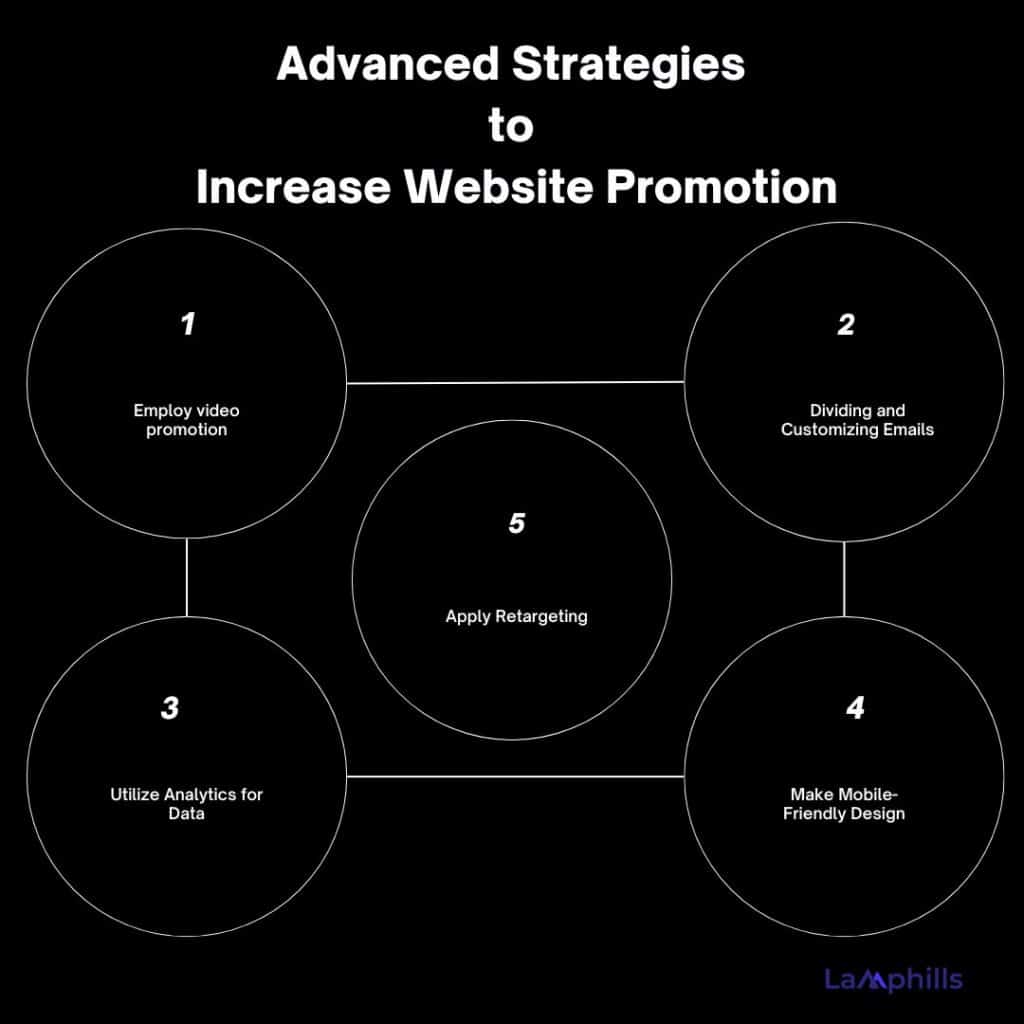To convey a company’s mission and highlight its products, a business website is now a must. Although it is now less expensive and easier than ever to launch a website, it is not always simple to connect with and engage your target audience. You may increase traffic to your website and improve your reviews by taking the time to properly analyze your target audience and create ways to get them to interact with it. The things I’ve learned about online website marketing strategy, business website marketing, company website marketing, and how to use advanced website marketing tactics to boost your business will all be covered in this article.
Key Points
- Gaining audience engagement and establishing your website as a reliable source is possible with content marketing. This is achieved by offering insightful, timely information via blogs, videos, and guides.
- Posting material regularly, interacting with people, and running advertisements on sites like Facebook and Instagram can increase website traffic.
- Customized advertising and email address collection via signups helps keep visitors and turn them into clients. Email marketing develops leads.
- Search engine optimization improves your website by boosting traffic from searches and its visibility on search engine results pages.
- Analytical techniques like Google Analytics enable you to monitor the effectiveness of your tactics and gradually enhance productivity.
What is the website marketing?
A website marketing technique is an approach that depends on outside sources, including social media and search engines, to provide targeted visitors to your website and boost conversions. The technique of using your website to promote your business is the essence of website marketing. It includes bringing in new clients, keeping them interested, and assisting them as they proceed via the sales funnel. Search engine optimization of content, social media marketing, email campaigns, and other techniques are all part of website marketing.
In my situation, I had to realize that having a website wasn’t enough to be a marketing tool.
It was a location similar to a shop on an empty street; unless I deliberately directed people there, nobody would know it was there. Making that online storefront into a hive of activity is the goal of website marketing. I saw and utilized my business website differently after coming to this knowledge.
What do you mean by web marketing?
Merely defining “web marketing” within the framework of my company was one of the initial actions I took to enhance my internet marketing. Any strategy that utilizes the internet to draw potential clients to your website is considered web marketing. As an illustration, consider:
#1. Pay-Per-Click (PPC) marketing
Paid advertisements that show up at the top of search results, giving them immediate access to clients.
#2. Direct Email Marketing
Email marketing is a useful tool for inviting clients back to the website, offering deals, and keeping them interested.
#3. Optimization for Search Engines (SEO)
Ensuring that by optimizing keywords, tags, and descriptions, your website shows up on the top page of search engine results.
#4. Content-Based Marketing
Generating engaging and pertinent information to draw in viewers and keep them interested, will eventually lead to profitable consumer behaviors.
I was aware I had to attract visitors when I initially started, but I had no idea how to start. I made the error of attempting to complete everything at once. Results didn’t show up until I figured out which online marketing techniques matched my target audience.
What are the 7 Ps of web marketing?
Throughout my drive to master website marketing, one of the most useful frameworks I came across was the “7 Ps of web Marketing.” It assisted me in organizing my plan so that my business goals were in line with doable actions. Applying these 7 Ps to your website marketing can greatly improve it:
#1. Process
Aim to provide the best possible client experience. To streamline the purchasing process and reduce friction, I included chatbots and comprehensive FAQs.
#2. Physical Evidence
References from satisfied customers, case studies, and reviews demonstrate that your company keeps its word. My webpage prominently displayed testimonials, which increased legitimacy and fostered a sense of confidence among potential clients.
#3. Product
Your website should prominently feature your offerings in terms of goods and services, along with thorough descriptions, top-notch photos, and pertinent features that cater to the demands of your target market. The direct display of my items’ USPs on the site, I discovered, piqued visitors’ interest from the first.
#4. Promotion
Promotion is key to bringing in visitors, via SEO to social media ads and influencer collaborations. I discovered my website’s reach grew as I varied my promoting strategies. Using terms related to my items in my targeted Google Ads, for instance, increased my online presence.
#5. People
Your brand is made up of people. I infused my website with a personal touch by sharing my entrepreneurial experience, adding a “Connect with the Team” section, and swiftly attending to client inquiries.
#6. Price
Building trust is achieved through competitive pricing or clear pricing structures. For me, increasing conversions involved including pricing comparison tables or special offers for new users.
#7. Place
Customers connect with my company mostly through my website. Increased engagement and lower bounce rates were a result of making it mobile-friendly, guaranteeing quick loads, and streamlining control.
I improved client engagement and increased conversion rates by putting more of an emphasis on these 7 Ps when developing my web marketing strategy.
The Differences Between Business and Company Website Marketing
Understanding the difference between business and company website marketing is crucial before implementing any methods. Despite their frequent interchangeability, these phrases contain subtle distinctions.
Company website marketing
The day I developed my first corporate website is still clearly in my memory. Having an internet presence to finally present my goods and services to the public thrilled me as a new business owner. I had assumed that all I had to do to achieve success was press “publish.” I thought customers would follow the website once it was up.
Nevertheless, following several weeks of essentially zero purchases and very little traffic, I realized that creating the website was only the first step. My internet marketing strategy was unclear. I discovered via trial and error that good looks and content aren’t the only things needed for business website marketing. If you properly promote your website, it may be a very successful instrument for business growth, regardless of whether you run an e-commerce store or a local one.
Success in website marketing requires an understanding of how to use it successfully. The end goal is to give your visitors a seamless and worthwhile experience that converts them into loyal customers, whether that is accomplished through email campaigns, social media, SEO, or content marketing.
The term “company website marketing” usually describes advertising campaigns that highlight a business in its entirety. The company identity, core values, and main services are showcased on the website, which acts as the brand’s face. Businesses that wish to highlight their leadership, knowledge, and culture, as well as B2B enterprises and service providers, frequently use this strategy.
Business website marketing
Website marketing for businesses is more focused on the client. It places a lot of emphasis on advertising goods and services directly to customers or clients. It’s about increasing revenue, bringing in new clients, and guaranteeing recurring business.
For businesses in retail, e-commerce, or any other service sector where individual transactions determine the bottom line, business website marketing is essential. If you want to grow your business, consider your website as a live, breathing organism that needs regular maintenance, changes, and strategic promotion. The secret is to take a planned and data-driven strategy when optimizing your website for search engines, testing PPC advertisements, or using content marketing to engage users.
In my situation, I quickly concluded that I required a combination of the two methods. The organization required business marketing to drive product sales and establish a strong reputation in addition to company marketing, which produced money. For the website to flourish over time, it was essential to strike a balance between the two strategies.
Online website marketing strategy
My attention turned to online website marketing strategy after I had a clear understanding of my website’s objectives. To draw in traffic, hold users’ attention, and turn them into buyers is the core of any website marketing plan. It can, however, feel overwhelming with so many options for strategies. Developing my online approach was a key factor in the success of my firm. I used advanced strategies to improve my website’s performance after I had mastered the fundamentals. The following were a few of my most successful online website marketing strategies or tactics:
#1. SEO (Search Engine Optimization)
SEO is essential to the marketing of websites online. Also, SEO makes sure that when people look up phrases associated with your company, their website appears highly on search engine result pages (SERPs). I didn’t first recognize SEO’s full potential. I didn’t have an optimization plan in place, which is why my site wasn’t ranking well.
However, I eventually started by looking up keywords related to my company and goods. I came across Google Keyword Planner and other tools, which made it easier for me to target high-traffic terms that prospective clients were using. I saw a slow but noticeable increase in organic traffic after putting on-page SEO tactics into practice, such as optimizing descriptive titles, descriptions, headers, and graphics.
#2. Encouraging Modern Users with Mobile Optimization
Developing my website for mobile consumers was a must in this era of mobile browsing. My original design was not mobile-friendly, which resulted in high bounce rates even though a significant amount of my audience visited via smartphones. I observed a notable increase in user engagement after installing a responsive design and enhancing the mobile experience (such as enabling links for accessible and speeding up pages).
#3. Retargeting Advertisements
These were retargeting visitors to my website to prompt them to finish their transactions.
In addition, I experimented with PPC (pay-per-click) campaigns as part of my online website marketing approach. PPC advertising can bring you visitors right away, but SEO requires time to display returns. Though I was first apprehensive about spending money on sponsored advertisements, I soon saw their value after starting a few focused Google Ads campaigns.
My website started showing up at the top of search results, in front of potential consumers, by placing bids on keywords related to my sector. As a result, more people who were already looking for my products saw my site, and it received high-quality traffic. Pay-per-click (PPC) advertising is an excellent way to drive traffic in short bursts, but when done well, it can also promote brand knowledge and exposure, which can have long-term implications.
#4. Adding Quality to Your Audience via Content Marketing
I overlooked the significance of great content in the initial stages of my website because I was too preoccupied with increasing sales. I made a grave error here. As soon as I realized the possibilities of content marketing, it changed my life. To begin with, I set up a blog with useful and timely posts. Visitor materials on subjects like “Tips for Improving Worth with (My Services)” and “In What Ways to Utilize (My Products) in Daily Life” were indispensable.
Positioning my website as a consultant in the field, not only increased trust with my audience but also improved SEO rankings. Since content provides continuous value, it is a fundamental component of many effective online website marketing campaigns. It attracts users to return, extends their stay on your website, and inevitably increases conversions. Make sure your material is helpful, interesting, and speaks to the issues that your target audience is facing.
#5. Integrating Social Media to Increase Your Reach
Developing a strong brand presence on social media platforms was a major component of my company’s website marketing strategy. I started advertising my content on social media early on as I saw that the majority of my clients were present on sites like Facebook and Instagram. This required genuine interaction, not simply the publishing of links.
I began to share product updates, blog entries, and even behind-the-scenes glimpses into my company’s workings. Consistency and interaction are the keys to social media marketing success. My community grew and my website’s traffic increased as a result of answering questions from customers, leaving feedback, and utilizing social media as a customer care tool.
#6. Keeping and Growing Leads via Email Marketing
One of the most successful marketing techniques I found for my company website was email marketing. Customers may not be prepared to buy right away when they visit your website. Yet, you can help turn that lead into a sale if you can get their email using a signup form that offers an incentive (like a free guide or discount).
Using visitor behavior (i.e., previous purchases), I divided my email list and sent out customized messages to each recipient. By doing this, I could customize my emails to fit particular clientele. Conversions and open rates for my customized marketing emails increased significantly. My ability to connect with leads at the appropriate time and convert website visitors into loyal clients was further enhanced by automated follow-up processes.
#7. Video Promotion
Engaging visitors with video testimonials, training, and product demos improved my website’s interaction.
#8. Marketing via Influencers or Partnerships
Bringing my brand to a wider audience through partnerships with social media influencers increased website traffic.
How to use website marketing?
Utilizing a variety of tactics that increase traffic, foster interaction, and turn visitors into buyers is the secret to successful website marketing. Here’s how to leverage website marketing to expand your company:
#1. Start with search engine optimization or SEO.
The foundation of a website marketing plan is SEO. For potential clients to find you easily, you need your website to rank highly in search engine result pages (SERPs). The process by which you make sure search engines, like Google, understand the content on your website and think it applies to users’ queries is called search engine optimization, or SEO.
My website’s SEO strategy:
- Writing Content: I used relevant keywords organically in my blog entries and product descriptions.
- Technical SEO: Rankings were improved by making sure my website was mobile-friendly, quick, and organized.
- To determine which search phrases would be most appropriate for my goods and services, I conducted keyword research using programs like Google Keyword Planner.
- The page’s headers, information, and meta titles undergo targeted keyword optimization.
#2. Put Email Marketing in Practice
One of the most effective online marketing strategies is email marketing since it lets you nurture leads and keep viewers engaged with relevant material.
The way I employed email marketing
- Customization increased open and click-through rates dramatically. Topic lines, deals, and content were tailored to the interests of the recipient.
- Email List Progress: I quickly accumulated a substantial email list by giving first-time visitors a discount in return for their email addresses.
- Classification: I sent tailored follow-up emails to email list subscribers depending on visitor behavior, such as those who browsed but didn’t buy.
#3. Put PPC Advertising to Use
Gaining rapid traffic can be achieved via pay-per-click (PPC) advertising, especially with Google Ads. When compared to SEO, which requires time to show outcomes, PPC ads can significantly boost web traffic.
How PPC advertising was employed by me:
- Pay attention to mobile optimization and user experience.
- To decrease bounce rates and boost conversions, you must make sure that users have an excellent experience on your website.
- Targeting keywords with high relevancy to my goods and services is how I bid on them.
- Retargeting advertisements: These advertisements sought to entice previous site visitors who had abandoned their carts to return and complete their purchases.
#4. Utilize Content Promotion
Attracting, interacting with, and converting visitors is made possible by content marketing. It involves offering insightful content that solves issues for your audience or gives them new perspectives on your sector.
The way I employed content marketing
- Instructional Materials: I grew my email list for future interaction by providing free downloadable materials (such as e-books or manuals) in exchange for email enrollments.
- Writing helpful, educational blog posts on my products, market trends, and how-to instructions regularly enabled me to establish trust and draw in targeted traffic.
- Plain texts did not generate as much interaction as short, interesting videos that showcased my items or provided advice.
#5. Data Analytics
Evaluating the effectiveness of your strategy is a critical component of managing online marketing successfully. You can’t determine what’s effective or which areas require development without monitoring and analyzing.
My approach to using analytics
- To maximize conversion rates, I conducted A/B testing using various website designs, headlines, and calls to action. My strategy was improved for better outcomes thanks to the new insights.
- Google Analytics: I kept an eye on important data points, including user behavior, conversion rates, and traffic sources. Thanks to this data, I could identify the pages that performed well and those that required improvement.
#6. Boost Traffic via Social Media
The ability to actively communicate with your audience is one of the key benefits of social media platforms in today’s online marketing strategy.
My approach to social media usage:
- Client Engagement: Responding to queries from clients and having real-time conversations with them on social media helps increase traffic and confidence.
- Paid Advertising: I connected with potential clients who weren’t following my business on social media by running targeted ads.
- Content sharing: To drive visitors back to my website, I posted updates, blog entries, and product releases on social media sites like Facebook, Instagram, and LinkedIn.
#7. Pay attention to mobile optimization and user experience
To decrease bounce rates and boost conversions, you must make sure that users have an excellent experience on your website.
How I enhanced the user experience:
- Easy Accessibility: I significantly increased user experience and decreased cart abandonment by streamlining my website’s design and the checkout process.
- Mobile Optimization: I ensured my site was responsive and had quick load times for mobile users, as they accounted for a significant amount of my traffic.
Advanced Strategies to Increase Website Promotion
After gaining a firm grasp of the fundamentals, it was time to explore advanced approaches to grow my company. For me, they were the most effective:
#1. Employ video promotion
The addition of video material was another revolutionary move. In addition to how-to movies, I made quick, interesting films featuring my items and client endorsements. Instead of just using words to describe complicated product aspects, videos helped users stay on the website longer and more effectively.
#2. Dividing and Customizing Emails
Email marketing was something I had always done to some degree, but it helped to personalize my campaigns. I was able to provide pertinent and targeted communications by dividing my audience into groups according to their actions (like the pages they browsed, etc.). More sales and increased open rates were the results of personalizing these emails.
#3. Utilize Analytics for Data
Data was one of the most potent instruments at my disposal. I started monitoring visitor behavior on my website with Google Analytics. It gave me the ability to observe which pages were receiving the most traffic, the origins of visitors, and the most engaging content. Making informed choices required the use of this data. One blog article I improved with better calls-to-action was “How to Use My Products,” for instance, because I saw it was receiving a lot of traffic. This increased the number of conversions on the page.
#4. Make Mobile-Friendly Design
My website has to be mobile-friendly, I realized when I saw that a significant portion of the traffic was coming via mobile devices. More than merely a convenience, a mobile-friendly design is essential. Reducing my bounce rates significantly involved using responsive design, speeding up load times, and making sure the checkout process functioned properly on smartphones.
#5. Apply Retargeting
Retargeting advertisements were launched by me when I discovered that a large number of first-time visitors depart without purchasing. These advertisements remind visitors to your website of the items they have previously viewed by following them. Following the introduction of Facebook and Google retargeting advertisements, I observed a notable rise in repeat visitors and a surge in conversions.

Evaluation of Achievement Is Crucial
One crucial thing I took away from my experience with internet marketing is that it’s an ongoing endeavor. Businesses need to keep up with the rapid changes in the digital landscape by being flexible and willing to learn. Knowing your audience, using data to make wise decisions, and utilizing cutting-edge strategies are essential for achieving any goal, whether you’re just getting started or trying to improve your approach. Data tracking and analysis is a crucial component of every online website marketing plan.
My monitoring of key performance indicators (KPIs), including traffic sources, conversion rates, and bounce rates, was made easier by tools like Google Analytics. Through the analysis of these indicators, I was able to optimize my tactics, concentrate on what was effective, and remove what wasn’t. Recall that attracting visitors, holding their attention, and winning them over as devoted clients are the three main goals of an efficient Internet marketing plan. Your company website can become an effective instrument for long-term success if you use the correct combination of strategies.
Conclusion
Building a strong online website marketing plan and promoting my company’s website has shown me that owning a website is only the first step in the process. An effective marketing plan that engages your audience generates traffic, and turns website visitors into devoted clients is crucial for online business growth. A strong website can help you expand your business if you use the correct tactics and make constant adjustments.
Creating a smooth, interesting user experience that turns visitors into customers and encourages them to return is ultimately more important than simply driving traffic to your website when using advanced online marketing strategies to grow your business.
Related Articles
- 15+ MARKETING WEBSITES EVERY MARKETER SHOULD KNOW
- What Is Organic Marketing: Why It Is Important and Ideas for Entrepreneurs
- 15 Marketing Video Examples to Inspire Your Next Campaign
- Social Media And Content Marketing: Building a Winning Strategy
- Branding vs. Performance Marketing: Which Strategy Drives Better Results?






